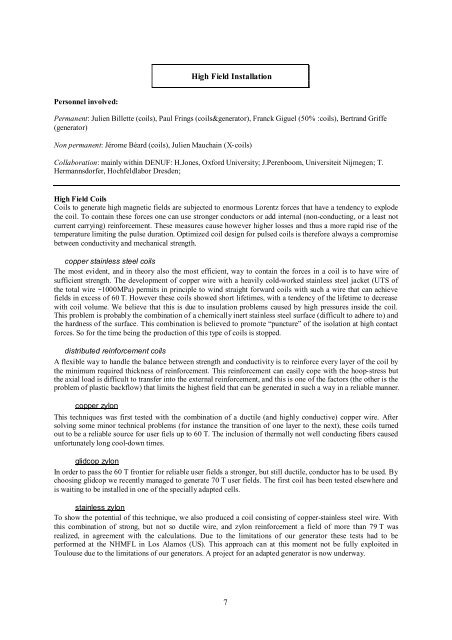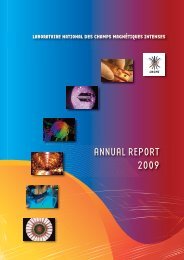Laboratoire National des Champs Magnétiques Pulsés CNRS – INSA
Laboratoire National des Champs Magnétiques Pulsés CNRS – INSA
Laboratoire National des Champs Magnétiques Pulsés CNRS – INSA
Create successful ePaper yourself
Turn your PDF publications into a flip-book with our unique Google optimized e-Paper software.
Personnel involved:<br />
High Field Installation<br />
Permanent: Julien Billette (coils), Paul Frings (coils&generator), Franck Giguel (50% :coils), Bertrand Griffe<br />
(generator)<br />
Non permanent: Jérome Béard (coils), Julien Mauchain (X-coils)<br />
Collaboration: mainly within DENUF: H.Jones, Oxford University; J.Perenboom, Universiteit Nijmegen; T.<br />
Hermannsdorfer, Hochfeldlabor Dresden;<br />
High Field Coils<br />
Coils to generate high magnetic fields are subjected to enormous Lorentz forces that have a tendency to explode<br />
the coil. To contain these forces one can use stronger conductors or add internal (non-conducting, or a least not<br />
current carrying) reinforcement. These measures cause however higher losses and thus a more rapid rise of the<br />
temperature limiting the pulse duration. Optimized coil <strong>des</strong>ign for pulsed coils is therefore always a compromise<br />
between conductivity and mechanical strength.<br />
copper stainless steel coils<br />
The most evident, and in theory also the most efficient, way to contain the forces in a coil is to have wire of<br />
sufficient strength. The development of copper wire with a heavily cold-worked stainless steel jacket (UTS of<br />
the total wire ~1000MPa) permits in principle to wind straight forward coils with such a wire that can achieve<br />
fields in excess of 60 T. However these coils showed short lifetimes, with a tendency of the lifetime to decrease<br />
with coil volume. We believe that this is due to insulation problems caused by high pressures inside the coil.<br />
This problem is probably the combination of a chemically inert stainless steel surface (difficult to adhere to) and<br />
the hardness of the surface. This combination is believed to promote “puncture” of the isolation at high contact<br />
forces. So for the time being the production of this type of coils is stopped.<br />
distributed reinforcement coils<br />
A flexible way to handle the balance between strength and conductivity is to reinforce every layer of the coil by<br />
the minimum required thickness of reinforcement. This reinforcement can easily cope with the hoop-stress but<br />
the axial load is difficult to transfer into the external reinforcement, and this is one of the factors (the other is the<br />
problem of plastic backflow) that limits the highest field that can be generated in such a way in a reliable manner.<br />
copper zylon<br />
This techniques was first tested with the combination of a ductile (and highly conductive) copper wire. After<br />
solving some minor technical problems (for instance the transition of one layer to the next), these coils turned<br />
out to be a reliable source for user fiels up to 60 T. The inclusion of thermally not well conducting fibers caused<br />
unfortunately long cool-down times.<br />
glidcop zylon<br />
In order to pass the 60 T frontier for reliable user fields a stronger, but still ductile, conductor has to be used. By<br />
choosing glidcop we recently managed to generate 70 T user fields. The first coil has been tested elsewhere and<br />
is waiting to be installed in one of the specially adapted cells.<br />
stainless zylon<br />
To show the potential of this technique, we also produced a coil consisting of copper-stainless steel wire. With<br />
this combination of strong, but not so ductile wire, and zylon reinforcement a field of more than 79 T was<br />
realized, in agreement with the calculations. Due to the limitations of our generator these tests had to be<br />
performed at the NHMFL in Los Alamos (US). This approach can at this moment not be fully exploited in<br />
Toulouse due to the limitations of our generators. A project for an adapted generator is now underway.<br />
7







